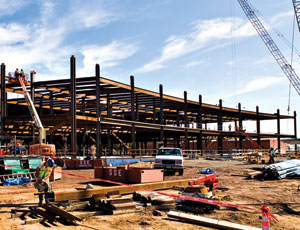A year after the global financial crisis and soaring bond rates rocked hospital construction programs around the country, health-care owners are continuing with expansion and renovation plans to enhance the patient experience, keep pace with future demand and boost operational efficiency. Although the economic turmoil caused several projects to be put on hold or shelved, a number of hospitals have managed to overcome economic challenges and move forward with capital investments. For example, Kaiser Permanente’s $500-million, 340,000-sq-ft hospital and 217,000-sq-ft medical office building in Vacaville, Calif., opened this fall after a six-month delay. Ohio State University Medical Center recently announced an ambitious $1-billion campus renovation that will include the construction of a new 17-story hospital tower, and in Indiana, St. Francis Hospital & Hospital Centers resumed work on a $265-million expansion to construct a six-story, 221-bed inpatient tower as well as additional facilities at its campus in south Indianapolis.


“Construction had been delayed because of the turbulent economic environment,” says St. Francis CEO and President Robert Brody at the health-care provider’s Beach Grove, Ind., campus. “Today the situation has improved. After careful and ongoing evaluation of key economic indicators and the financial performance of the hospital, the board of trustees voted to resume the project at full steam ahead.”
As health-care owners proceed with projects, many are discovering a silver lining to the economic storm: lower materials costs and increased availability of equipment and laborers.
“Surprisingly, the issues with the economy haven’t hurt our project. The downturn has actually helped us,” says Barry Rabner, CEO and president of Princeton Healthcare System, Princeton, N.J. “Most of the bids have come in at or below budget.”
Construction began on the $442-million University Medical Center of Princeton at Plainsboro in fall 2008 and is scheduled to be completed at the end of 2011. The 636,000-sq-ft hospital will serve as the hub of a 160-acre campus and house 238 beds, emergency and ambulatory services, operating suites, laboratories, an education center, acute rehabilitation services and cancer center.
Children’s Hospital of Alabama also saw costs shrink on its 720,000-sq-ft expansion. Construction deflation reduced the project’s price tag by $17 million, to $400 million.
“The building was originally going to be constructed mostly of steel, but we decided a hybrid design of three-fourths concrete frame and one-fourth steel would be the best combination for cost and schedule reasons,” says Mike McDevitt, Children’s Hospital of Alabama executive vice president, in Birmingham, Ala. “During the recession, the project also benefitted from strong competition among contractors and contractors’ ability and willingness to allocate additional equipment to jobs, which has helped with the schedule.”
Hospital owners say they are choosing designs that are more patient-centric and which prevent medical errors and can accommodate increasing patient volumes, future technologies and changes in the delivery of health-care services.
A growing number of health-care facilities are being constructed with the patient’s experience in mind, owners say. Designers and architects are applying an aesthetic more commonly found in the hospitality industry to transform hospitals into tranquil environments and using evidence-based design to reduce infections, falls, patient stress and errors made by caregivers.
Self-check-in kiosks, a concierge desk, warm finishes, contemporary furnishings and floor-to-ceiling windows are some of the amenities and design aesthetics being incorporated into the new University Medical Center of Princeton to make it more inviting.
“These changes were not about creating a hotel atmosphere simply for marketing purposes but about creating a soothing environment that reduces stress for patients, families and hospital staff,” says Rabner. “Hospitals can be very stressful places, and research has shown that stress increases errors and poor communication, which increases poor clinical outcomes. We are trying to solve this problem.”
The University Medical Center of Princeton and other owners are trying to further improve patients’ hospital...


Post a comment to this article
Report Abusive Comment